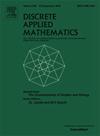关于双平面和k平面交叉数
IF 1
3区 数学
Q3 MATHEMATICS, APPLIED
引用次数: 0
摘要
图G的双平面相交数是在两个不相交的平面上G的所有可能的边的相交数的最小值。给出了完全图和完全二部图的双平面交叉数的新界限。特别地,我们证明了完全二部图的双平面交叉数可以在一个优于3的因子内逼近,改进了先前已知的最佳因子4.03。对于完全图,我们建立了3.17的近似因子,提高了4.34的最佳先验因子。对于任意正整数k,我们给出了完全图和完全二部图的k-平面交叉数的类似改进界。我们还更深入地研究了一般图的(普通)交叉数与双平面交叉数之间的关系。特别地,我们证明了任何相交数不超过11的图都是双平面的。本文章由计算机程序翻译,如有差异,请以英文原文为准。
On the biplanar and k-planar crossing numbers
The biplanar crossing number of a graph is the minimum number of crossings over all possible drawings of the edges of in two disjoint planes. We present new bounds on the biplanar crossing number of complete graphs and complete bipartite graphs. In particular, we prove that the biplanar crossing number of complete bipartite graphs can be approximated to within a factor better than 3, improving upon the best previously known factor of 4.03. For complete graphs, we establish an approximation factor of 3.17, improving the best previous factor of 4.34. We provide similar improved bounds for the -planar crossing number of complete graphs and complete bipartite graphs, for any positive integer . We also investigate the relation between (ordinary) crossing number and biplanar crossing number of general graphs in more depth. In particular, we prove that any graph with crossing number at most 11 is biplanar.
求助全文
通过发布文献求助,成功后即可免费获取论文全文。
去求助
来源期刊

Discrete Applied Mathematics
数学-应用数学
CiteScore
2.30
自引率
9.10%
发文量
422
审稿时长
4.5 months
期刊介绍:
The aim of Discrete Applied Mathematics is to bring together research papers in different areas of algorithmic and applicable discrete mathematics as well as applications of combinatorial mathematics to informatics and various areas of science and technology. Contributions presented to the journal can be research papers, short notes, surveys, and possibly research problems. The "Communications" section will be devoted to the fastest possible publication of recent research results that are checked and recommended for publication by a member of the Editorial Board. The journal will also publish a limited number of book announcements as well as proceedings of conferences. These proceedings will be fully refereed and adhere to the normal standards of the journal.
Potential authors are advised to view the journal and the open calls-for-papers of special issues before submitting their manuscripts. Only high-quality, original work that is within the scope of the journal or the targeted special issue will be considered.
 求助内容:
求助内容: 应助结果提醒方式:
应助结果提醒方式:


